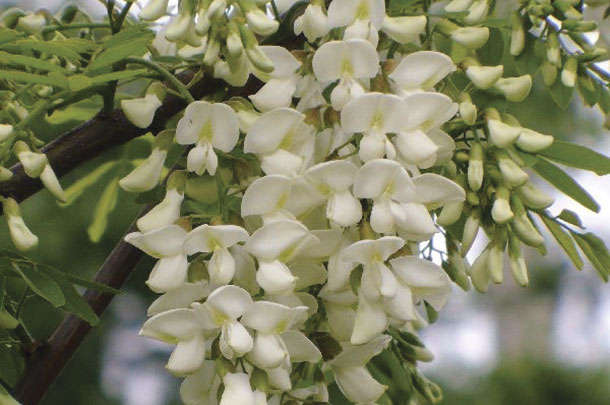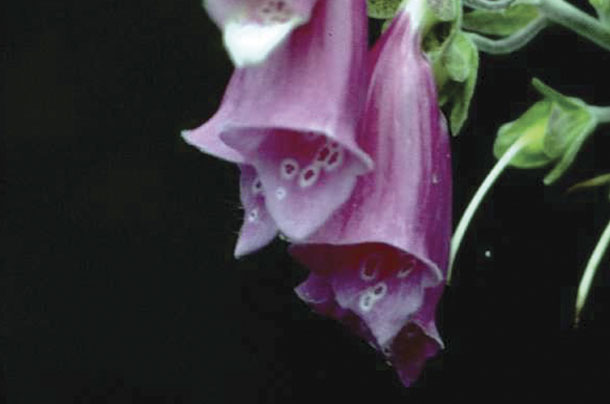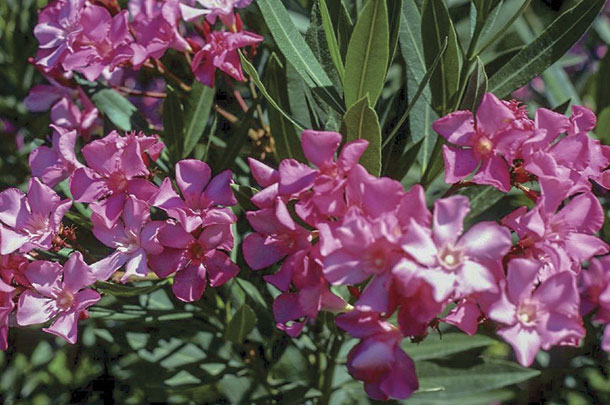So you throw on some clothes because this always happens at night, and your muck boots and bring the nighttime travelers back to their own pasture. Other than an annoyed neighbor threatening to sue you for the free fertilizer and mown grass, everything is fine, and you go back to bed. When you wake up, you notice a few cows appear to be in distress. What in the world could they have eaten?
Well, unfortunately, it could have been a lot of things. Your neighbor’s yard, and many backyards, are full of ornamental plants that are toxic. First, familiarize yourself with the USDA hardiness zone map – which allows you to enter your zip code to find your growing zone.
The following list of toxic plants is meant to cover the most common ornamental plants toxic to livestock and that grow in most all areas of the U.S. So when you are looking for the culprit, check over the fence for these plants:

- Angel’s trumpet, aka datura, is a 10-foot perennial with a pretty flower that is common in garden nurseries. It is a large shrub with long flowers that hang down and, while it is a beautiful plant, it is also toxic to most livestock species with the chance of death. This plant grows in zones 9 to 11. Toxicity symptoms can include bloat, disorientation, rapid heart rate, convulsions and coma.
- Black locust is found in the Appalachian and Ozark mountains in zones 4 to 8. Though it is a very hardy and fast-growing tree that makes for excellent fenceposts, the seeds, bark and leaves contain toxic proteins. Toxicity symptoms include poor appetite, weakness, paralysis, gastrointestinal distress, an abnormal heartbeat and possible death.

- Buckeye tree fruit is poisonous to all animals, although it is unknown what the toxin is. They are a medium-sized, deciduous tree with chestnut-like seeds that are poisonous. They grow in zones 4 to 7. Muscle twitching, coma and death can occur in livestock that consume the fruit.
- Buttercups can be found throughout the U.S. and are often selected by livestock when there is little else to eat. There are many varieties and species of buttercups and their toxic relatives. Most species have a very shiny flower and grow in zones 7 to 11. Consumption causes blistering throughout the gastrointestinal tract.
- Castor plant is the deadliest garden plant worldwide, and it grows in most hardiness zones. It has beautiful foliage that makes it popular, but it takes very little to be toxic. It grows in most of the U.S. either as a perennial or an annual depending on the USDA hardiness zone. All parts of this plant are toxic, but the oil is used in cosmetics, medicines and motor oil. The bean, that looks like a full tick, has a highly toxic protein called ricin. Symptoms of toxicity are gastrointestinal distress and bloody diarrhea.
- Cherry trees’ (wild, black and choke) leaves release cyanide into the animal’s bloodstream. Mucous membranes will be bright red and so will the blood. Also, convulsions, weak pulse and quick death will occur. Choke cherries grow in zones 2 to 10 along with most other types of cherry trees. The leaves are toxic and, after a frost, cyanide is released, making the plant taste sweet which increases animal susceptibility during that time.
- Daffodils are commonly planted and have a pretty springtime bulb. The bulb or root of the plant is toxic and fatal to horses. It can have a white, yellow, orange or pink flower and most often grow in zones 3 to 8. Symptoms of toxicity include clumsiness, convulsions and gastrointestinal symptoms.

- Foxglove is commonplace in Pacific Northwest flower gardens. Not only is the plant toxic to ruminants but also to all animals, though it is used in human pharmaceuticals for treatment of congestive heart failure symptoms. It has a tall stem with many small flowers that look like small trumpets. They can grow in zones 4 to 8. Horses are susceptible and will have bloody diarrhea, staggering, arrhythmia and sometimes death.

- Golden chain tree grows in zones 5 to 9 and can become quite large. The foliage is toxic to horses and livestock. Symptoms of toxicity include convulsions, colic, gastrointestinal distress, frothing at the mouth, loss of coordination and muscle spasms.
- Oleander is a pretty, but very toxic, flowering shrub. It is most often consumed when an animal has little else to eat. All parts of the shrub are toxic, and the smoke from burning the shrub is also toxic. It grows on the southern and western borders of the U.S. and produces flowers in yellow, white, pink and red.
It can grow quite large in very poor soils, and it grows in zones 8 to 10. The plant causes heart arrhythmia and death. It takes very, very little of the plant to be lethal and is toxic to humans, pets, livestock and birds. This plant needs to be handled with very great care.
- Rhododendron, lily of the valley and azalea are very common, pretty ornamentals – and are toxic and can be fatal to livestock. These are woody, shrub-like plants with beautiful flowers in many colors. They can grow in zones 3 to 11. The toxin in the plant causes bloat, salivation, diarrhea and colic. If the plant continues to be consumed, it will lead to abnormal heart rate, clumsiness, convulsions and then death. The minimal dose required to produce adverse effects is 0.2 percent of bodyweight.

- Wisteria is a climbing vine and a legume that is woody and introduced to the eastern U.S. They can grow tall and wide. The largest plant is in Sierra Madra, California, and has grown to greater than 1 acre. The flower bundles are purple, violet, pink or white and are very beautiful. All parts of the plant is toxic and are poisonous to horses and pets. It only takes a few seedpods to be lethal to a horse and can cause gastrointestinal issues and blood clots that can trigger a stroke.

- Yew is an ornamental with several species that cover much of the U.S. It is a dark green evergreen shrub, often used in Christmas wreaths. It grows in zones 4 to 8. It is toxic to all animals and death can occur in as quickly as one to 48 hours after ingestion, depending on the type. Other symptoms include colic, diarrhea, weakness and seizures.
No one wants an animal in our care to be sick, and poison is a terrible way to have animals die. If you suspect your livestock, pets or horses have been in contact with any toxic plant, it is best to call a veterinarian for further instructions. Many of these plants are also toxic to humans. Take great care around these plants, and keep children away from them as well.
A quick internet search will reveal many toxic plants areas, and you can contact your local extension office, NRCS, Master Gardener group or nursery for a more comprehensive list in your location. ![]()
PHOTO 1: Black locust
PHOTO 2: Daffodil
PHOTO 3: Foxglove
PHOTO 4: Oleander
PHOTO 5: Rhododendron
PHOTO 6: Wisteria. Photos courtesy of USDA.

-
Tyanne Roland
- Extension Educator
- University of Idaho
- Email Tyanne Roland











